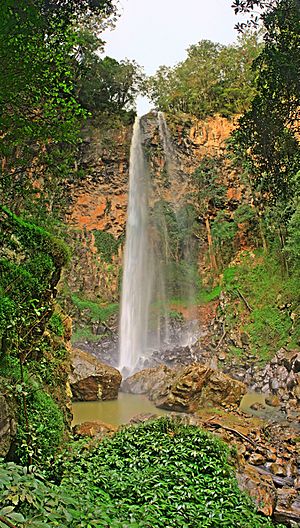Boorganna Nature Reserve facts for kids
Quick facts for kids Boorganna Nature ReserveNew South Wales |
|
|---|---|
|
IUCN Category Ia (Strict Nature Reserve)
|
|

Southern angle headed dragon in the reserve
|
|
| Nearest town or city | Comboyne |
| Established | 12 March 1904 |
| Area | 4 km2 (1.5 sq mi) |
| Managing authorities | NSW National Parks & Wildlife Service |
| Website | Boorganna Nature Reserve |
| See also | Protected areas of New South Wales |
The Boorganna Nature Reserve is a special nature reserve in New South Wales, Australia. It's located northwest of Taree on the Comboyne Plateau. This reserve is about 396 hectares (that's like 978 football fields!). It was created in 1904, making it the second oldest nature reserve in New South Wales.
Boorganna is famous for its amazing rainforests, especially the sub-tropical kind. You can find huge rosewood, yellow carabeen, and small leaf fig trees here. This reserve is a small piece of a much bigger rainforest that used to cover the Comboyne Plateau. Most of that forest was cleared between 1900 and 1925.
Even though it's a beautiful rainforest, Boorganna Nature Reserve was not included in the UNESCO World Heritage list. This is because it's a bit far away from the other rainforests in that group.
Contents
Visiting Boorganna Nature Reserve
This reserve is a great place to visit! You'll find a picnic area with tables and chairs right next to the forest. It's a perfect spot to enjoy a meal and watch small birds. There are also walking trails that lead to a lookout point for Rawson Falls. You can learn more about the reserve from the information board.
The reserve is about 32 kilometers north of Taree, and you can get there through Wingham. If you're coming from Wauchope, it's about 35 kilometers away. The town of Comboyne is only about 6 kilometers from the reserve. You can also reach it from Port Macquarie and Tamworth via the Oxley Highway.
Land and Weather
Boorganna Nature Reserve gets a lot of rain, about 1930 millimeters each year. The weather is sub-tropical, which means it's warm and humid. However, because the reserve is high up (between 360 and 732 meters above sea level), it's usually cooler than the nearby coast.
The soil here is a deep red color. This is because it comes from ancient Miocene basalt rock. In some parts, especially near the Great Dividing Range, you can see cliffs, rocks, and shallow soils. There are also deep gullies and sharp, rocky ridges.
Animals of the Reserve
Many animals live in the rainforest, but you might not always see them. Most of them are nocturnal, meaning they are active at night. Some of the animals you might find include bats, wallabies, possums, gliders, spotted quolls, platypus, bandicoots, pademelons, bush rats, snakes, lizards, and antechinus.
Birdwatching here is amazing! There are about a hundred different bird species. You might spot colorful rainforest pigeons like the rose-crowned fruit dove and wompoo fruit dove. Other special birds include the noisy pitta, green catbird, and figbird.
There are also many tiny creatures in the rainforest. These include insects, spiders, snails, and worms. After it rains, you might notice leeches if you're walking through the bush. On the forest floor, you can see Red triangle slugs and blue planarians. Look up, and you might even find tree-dwelling snails!
Plants of the Reserve
Sub-tropical Rainforest
The sub-tropical rainforest feels like a dark, lush jungle with many huge trees. Some trees grow very tall and have wide trunks. These include the yellow carabeen, small leaf fig, Moreton Bay fig, rosewood, black booyong, giant stinging tree, pigeonberry ash, brush box, and silver quandong. Smaller interesting plants are the walking stick palm and the Macleay laurel.
Boorganna Nature Reserve is special because some plants here are growing at their most southern natural limit. This means you won't find them much further south. Examples include the sour cherry, purple cherry, white apple, turnipwood, and the red carabeen.
Other Rainforest Types
- Warm Temperate Rainforest: In areas with less fertile soil, you'll find different trees like the coachwood, watergum, sassafras, and lilly pilly.
- Gully Rainforest: This type of rainforest grows in narrow, steep gullies. It has a mix of plants from both sub-tropical and warm temperate rainforests, like the whalebone tree, walking stick palms, and the Bangalow palm.
- Dry Rainforest: Where the soil is shallow and there's less rain, you'll find dry rainforest. Trees here include the grey myrtle and shatterwood.
Eucalyptus Forest
In parts of the reserve where fires happen more often, you'll see Eucalyptus trees. In wetter areas, there are tall Sydney blue gums, brush boxes, tallowwoods, and New England blackbutts. Some of the tallowwood trees are incredibly tall! In drier areas, where there are strong winds and shallow soils, you'll find trees like the black sheoak.
Fungi
After rain, especially in autumn, you'll notice many colorful and interesting fungi in Boorganna Nature Reserve. The "bracket rainbow fungus" is often seen growing on fallen logs.
Images for kids
-
Sour cherry at Boorganna Nature Reserve
-
Small leaf fig at Boorganna Nature Reserve
-
Small leaf fig bark at Boorganna Nature Reserve
-
White beech at Boorganna Nature Reserve














